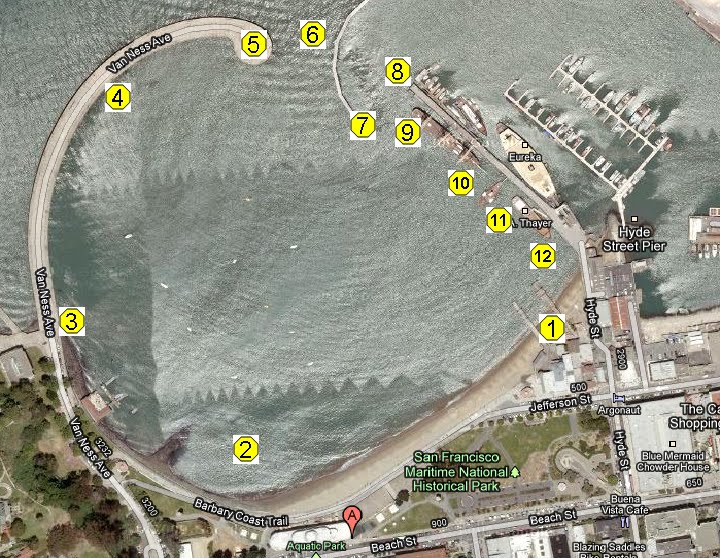Sunday 03/07/10
I’ve asked many Channel swimmers what they think about on their long training swims. Not one has given an answer that I can succinctly summarize. Maybe that’s because they think about a lot of things.
Before starting this project, the longest time I’d swum in the water was about three and a half hours. Pat M and I swam from Sausalito to San Francisco one summer a few years ago. Had we made our intended landing point, it would have taken closer to two and a half hours, but we misjudged the tide and started late. Much like missing Cap Gris Nez on a Channel swim, swimmers who miss Aquatic Park on a flood tide must chase a receding San Francisco shoreline as the current carries them east.
Since we started in the pitch black at five a.m., the first thing I thought about was getting in the water without serious injury. The traditional launch for this swim is at the sea lion sculpture on the Sausalito waterfront. The statue sits near water level and is constantly washed with surge. This makes the pedestal, the walkway, and the surrounding rip rap as slick as snot. We cleared this hurdle with only minor mishap.
The second thing I thought about was how silky the water felt. We seemed to slip through it with less friction than the water in cove. Then, I thought about keeping a steady pace with Pat. We had practiced together many times in Aquatic Park, including a couple of two hour swims. We were pretty evenly matched, but I wanted to make sure I kept up. Then, I started thinking about how long it would be before we could see the Golden Gate Bridge. By then it was time for a feeding—a partial packet of GU; a slug of water; and back to stroking.
After the second feeding, I really don’t remember thinking of much at all other than getting across the Bay. When the current pushed us east to Alcatraz Island, Laura B announced that we’d “treat it like a Channel swim.” From then on we’d try to get to San Francisco, regardless of location of landing. At this point, I remember being determined not to climb back into the boat until we were across. Other than that, it was just a series of, “Ding! Feed time,” followed by slurp, slug, and go. In fact, that is one of the regular pieces of advice appearing on the channel_swimmers Google chat site. “Just swim from feed to feed until you finish.”
What I find now that I’ve dramatically increased my weekly swim mileage is that I mostly think about my stroke. That would have been hard to imagine before the instruction from Coach Val. For hours, I now concentrate on stroke mechanics. I think about each hand entering the water directly above my head. I think about a strong, positive “catch” of the water with my hand. I think about a bent arm pull directly past my face and down the centerline of my body. I think about a smooth, powerful glide. I think about a relaxed recovery. I think about my toes ticking each other to indicate that my legs are not flying apart. I think about swimming through a narrow tunnel. I think about pushing water as far behind my toes as possible. There’s a lot involved in the swimming stroke. Who wudda thunk it?
Occasionally, I’ll practice breathing on the left side and then my thinking gets over-thought. My brain goes into over-drive. My stroke no longer feels natural. Left-side breathing is something I’ll have to keep thinking about.
In the Aquatic Park Cove, I spend time thinking about avoiding collisions with people and things. When it's dark, buoys and flotsam demand keen attention. With the water getting warmer, swimmers who use wetsuits are coming out in greater numbers earlier than normal for the season. They often swim in rather large groups and create a swim obstacle course. With the currents shoving and pushing in different directions, sighting a course is something to regularly think about. Swimming under the “round house,” I think about staying equidistant between the concrete support columns. I think about avoiding the nasty, broken wooden pier post at the periphery. It pokes its jagged barnacle-encrusted head above the water at the lower tides and forces a swimmer to carefully navigate. At times like this, my stroke suffers.
On the longer Bay swims, though, the pilot does the thinking about course and collision avoidance. Then, I think almost exclusively about stroke and swimming from feed to feed. It’s hard to believe, but true.
6 years ago


No comments:
Post a Comment